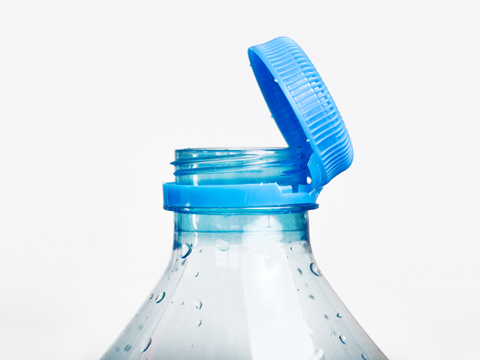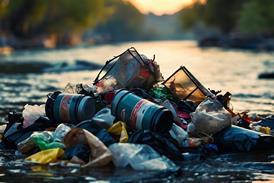
Why do so many consumers hate tethered bottle caps? Despite their role in ensuring that plastic lids can be recycled properly, numerous viral social posts over the past year have branded them as uncomfortable, inconvenient, and frustrating. Why, and what can be done to improve their reputation? Emma Liggins finds out.
At a recent social gathering, I was discussing Packaging Europe and its audience when one listener passionately chimed in: “Can you tell them to do something about the Coca-Cola lids?!”
They were referring to attached caps, which have been introduced to Coca-Cola bottles in recent years. Tethering the ‘100% recyclable’ plastic lids to their corresponding bottle necks is expected to prevent them from escaping the recycling stream, becoming litter, or entering landfill.
According to research from the European Commission, plastic bottle caps are among the most common items of litter found on coastlines. They fall within the top five most common pollutants on the shores of the North and Black Seas, and the top three near the Baltic and Mediterranean – constituting up to 14% of all the waste found in the latter case. Stichting De Noordzee also claims to have identified between 20 and 128 bottle caps per kilometre on the Dutch coastline of the North Sea, attributing more than 80% of the 10,004 collected in total to food and drink packaging.
Moreover, Ocean Conservancy cited bottle caps as the fourth most collected item of waste worldwide in 2023 – the second most collected in North America, the third in Latin America, and the fifth in the Caribbean and Central and South Asia. It is not only humans paying the price, either; this past summer, an endangered Northern Royal Albatross chick in Pukekura, New Zealand was found to have regurgitated four plastic caps, among other pollutants.
In response, Article 6 of Directive (EU) 2019/904 – the Single-Use Plastics Directive – states that single-use beverage containers of up to 3L in size “may be placed on the market only if the [plastic] caps and lids remain attached to the containers during the products’ intended use stage.” As of July 2024, this Directive has entered into force and is legally mandated across the EU.
None of this convinced my interrogator. Instead they claimed, perhaps hyperbolically, that they would rather fill the River Thames with wasted caps than deal with the inconvenience of fitting their lips around a plastic tether.
A matter of convenience
Those in the pro-tether camp generally question the uproar over what is, in their view, a mildly inconvenient adjustment for wider benefits. In a YouGov survey, 32% of 4938 British respondents said they ‘tend to support’ a legal mandate for attached caps, and 21% declared themselves strong supporters.
Companies like Coca-Cola argue that attaching caps prevents them from getting lost and becoming pollutants; this has the additional hygiene benefit of keeping stray lids off the ground, as testers of Bericap’s ClipAside Tethered Caps highlighted.
As of this publication, though, 70.7% of 18,467 respondents have told The Journal they do not like attached caps. Even before they were mandated, only 26% of 3,200 European adults surveyed by Sidel truly believed that tethers would help reduce plastic litter. Critics have since voiced concerns that they could consume between 50,000 and 200,000 more tons of plastic annually, generating up to 381 million more kilograms of CO2 equivalent.
Regardless, the crux of the controversy lies in user-friendliness and product safety. Sidel’s respondents criticized attached cap prototypes for causing discomfort against the nose and lips while drinking. Years later, comments on a now-deleted TikTok in which user ringsidegabs expressed frustration with Coca-Cola’s new caps blamed the tethers for cuts and blisters on their hands when opening their drinks, and for leaks after resealing them.
Benefits have been identified for consumers with disabilities like dyspraxia and, in the case of disability advocate Molly Burke, blindness. Not everyone finds it easy to retrieve a fallen cap, and frequently replacing lidless bottles becomes an unnecessary financial burden on disabled consumers, argues Lund University student Yanyan Huang. Still, other sources warn that current tether designs are too sharp, risking injury to the visually impaired, the elderly, and children.
Several of ringsidegabs’ commenters admitted to breaking the tethers for easier use, with ringsidegabs doing the same on camera. Naturally, though, pulling the plastic apart with force risks spilling the beverage. Also, even if the tether is cut with scissors or a knife, it undermines the purpose of attaching a cap. Not only is the lid now loose again, but the unused, broken tethers will inevitably add up and generate more plastic waste.
Berndt+Partner CEO Thomas Reiner considers all this an avoidable inconvenience. He points to the flip-top, or Bügelverschluss, as “everything that modern tethered caps should aspire to be but fall short of achieving.” Its bail holds the stopper away from the consumer’s face and prevents the discomfort caused by plastic tethers while facilitating easy opening and resealability, he explains.
Even so, mandating attached caps “seems redundant” to him when Germany’s national recycling system “has already minimized cap loss” (he claims that over 91% of bottles are returned with caps still attached). Not every country can say the same, but Reiner’s criticisms suggest that plastic tethers aren’t a one-size-fits-all approach.
Rebuilding consumers’ trust
The cynicism goes further than just design. Various TikTok commenters joked that attached caps were introduced “because we can’t be trusted to put the lid back on when we recycle the bottle”, or “so you can throw [the bottle and cap] away and [they’re] still polluting together”. This pessimism extended into one user’s frustration that they must “recycle the lid on [their] Sprite while billionaires get their private jets to travel two miles down the road”.
Perhaps these attitudes are unsurprising. Consumers are frequently urged to change their behaviours and adjust to new concepts while wealthy individuals and corporations are permitted to continue with business as usual – often causing far more damage than the average person.
Although 73% of consumers are theoretically willing to change their consumption habits, the general public is becoming less convinced of its culpability and more fatigued by corporate blame-shifting. A study from the University of Chicago’s Energy Policy Institute saw American respondents declare corporations the most responsible for climate change (62%), and individuals the least (41%). The latter figure has decreased by 9% since 2019.
This is not to suggest that consumers bear zero responsibility, nor do they seem to think so. Yet they are asked to accept discomfort at best or injury at worst in the name of improving recyclability, all while recycling capacities continue to stall and every EU Member State has fallen short of legally binding recycling targets.
If they want to win consumers over, brands need to respect and respond to this frustration. No designer or manufacturer can singlehandedly boost recycling rates or rewrite EU law, but they can go back to the drawing board and find more user-friendly methods of tethering plastic caps. After all, it is not unreasonable to expect comfort and convenience from something as ordinary as a beverage bottle.
If you liked this story, you might also enjoy:
The ultimate guide to the Packaging and Packaging Waste Regulation in 2024
How are the top brands progressing on packaging sustainability?
Sustainable Innovation Report 2024: Current trends and future priorities
Everything you need to know about global plastic sustainability regulation























No comments yet